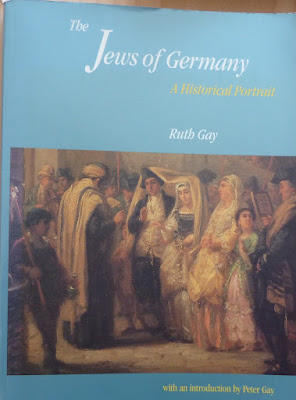So, reading wise I finished the end of Brecht's third book on Luther on the "Jews, Turks and Pope". This was instructive. This section dovetails with a book I am also reading about the history of the Jewish people in Germany:
For a little idea I will tell you that the last bit I read was about the Shabbatean mysticism, which was a movement that calculated the arrival of the Messiah to a particular year, led by Shabbetai Zevi. Calculating the year of arrival of the Messiah was a pre-occupation of some streams of Judaism, utilizing secret knowledge of numbers, etc. The Shabbatean movement swept across Jewish communities in Europe, including those in Germany, inducing individuals to sell their goods and make plans to go to Palestine:
After dividing up the kingdoms of the world among his followers, Shabbetai Zevi set sail in December for Constantinople. But when his ship arrived there in February 1666, he was arrested and held by order of an alarmed vizier. Undeterred, pilgrims came from afar to visit him, while preparations for the messianic age continued through the diaspora. Shabbetai Zevi, brought before a court attended by the Sultan, was accused of having represented himself as the Messiah and was given a choice between death and conversion to Islam. In a mood of deep dejection, he agreed to submit to the Islamic faith, in which he nominally remained until his death in 1676.
Even this betrayal did not burst the bubble of Jewish ardor. While the rabbinate tried to hush up the whole affair, true believers sought higher justifications for these stunning events, and the powerful effect of that intense messianic year, 1666, survived in Jewish culture as the core of an underground mystical doctrine that lasted into the eighteenth century. It became a public scandal in 1751, when Jacob Emden, a rabbi in Emden, accused Jonathan Eybeschuetz, the eminent rabbi of Hamburg, of distributing secret amulets with Shabbatean inscriptions. Although an international council of rabbis exonerated Eybeschuetz, the aura of shabbateanism clung to him... p. 83
So much. After that comes a section on "The Court Jew", who was apparently a richer individual "who served a prince or noble lord, most often as financial advisers and bankers but also as tax administrators, suppliers of military materiel [sic?] like horses, provisions, and weapons, or purveyors of jewels, antiquities, and other luxuries. These Jews, who profited immensely from their opportunities, also lived in two worlds. Dressed in the latest fashion, exempt from the onerous badge and other marks of Jewish dress, speaking several languages and well educated, they enjoyed the advantages of their wealth. Yet serving at the pleasure of a prince who might prove fickle, whose mind might be turned against hem, who might suddenly die, made theirs a hazardous occupation. Always the outsider and dependent on the goodwill of his patron, the court Jew was easy game for a discontented prince and a visible target for his subjects." (p. 84)
-- Ok, that's it for today. (Since Luther's time the emperor had required the Jews to wear distinctive clothing featuring a yellow ring as an unmistakable sign of identification--or rather stigmatization. Another result was the creation of ghettos.)
I am also reading Heiko Oberman's "The Dawn of the Reformation: Essays in Late Medieval and Early Reformation Thought". This one has many untranslated sections in German, French and Latin, which I am very happy to report I can read, since I spent my entire childhood, so it seemed at the time, memorizing vocabulary in all those languages. Now I know what all this torture was for ("aha" moment)--so one can read books such as this one. (Between my mother and the nuns it was language study and more language study. -- It's just I've never read a book like this, spiked through and through with not so short quotes in various languages.)
These essays are very precise.





No comments:
Post a Comment